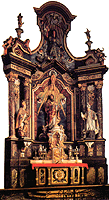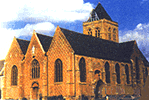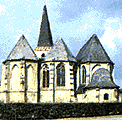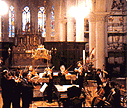
Typical elaborate wood screen behind
the altar, using paintings and statues to convey a powerful
religious message
|
Baroque altar screens
These colourful screens were part of the religious revival
that swept the Roman Catholic church in the 16th century,
when it finally woke up to the fact of the Reformation and
the threat of protestants breaking away. Such decoration
behind the altar was not new, but the exhuberant form of it
was a fashionable “craze” - every church had to
have a lavish elaborate wooden screen with pillars,
paintings and 3-D statues.
Emotional religious message
Church leaders hoped that vivid art, carrying a simple,
powerful message would stir pious emotions in ordinary
worshippers. They decorated churches with art representing
Christ, the saints and scenes from the Bible. The altar was
the focus of attention during a service
The “over-the-top” style in
architecture and decoration was termed “baroque”,
which was meant at the time as a criticism.
|
|
Hallkirks
  
1.
Church at Esquelbecq.
2.
Church at West-Cassel.
3.
A concert in front of one of the area's famous
altar-pieces
Many new churches were built called
“hall-kirks”, with three naves to bring the
congregation closer to the priest and the altar. It was all
part of the revival of the catholic church, tackling the
corruption and abuses of the Middle Ages.
|


